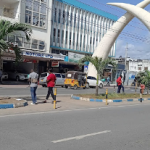When two American astronauts launched on a test mission to the International Space Station on June 5, they anticipated returning home within days. However, their plans have changed unexpectedly.
Barry “Butch” Wilmore and Sunita Williams are still aboard the station, floating high above Earth nearly two months later. Now facing the possibility of missing the entire summer and potentially spending Christmas and New Year in space, the pair is stuck indefinitely.
Mr. Wilmore, 61, and Ms. Williams, 58, flew a Boeing Starliner spacecraft to the station. This was the first crewed flight of its kind, intended to test the new spacecraft’s performance before regular use.
However, issues arose during its approach, including leaks in the propulsion system and some thrusters shutting down. While they reached the space station safely, they will need a different means of transport to return home if the Starliner is not deemed safe for re-entry.
At a news briefing on Wednesday, NASA officials indicated that no definitive decisions have been made regarding the next steps. “Our prime option is to return Butch and Suni on Starliner,” stated Steve Stich, manager of NASA’s Commercial Crew Program. “However, we have done the requisite planning to ensure we have other options available.”
One option being considered involves attaching the two astronauts to a mission set to launch in September, allowing them to return to Earth with that mission in February 2025. This flight to the space station will utilize a SpaceX Crew Dragon craft. Initially, four crew members were expected on that flight, but two seats could be left empty if needed.
This plan would extend the astronauts’ stay on the International Space Station from eight days to more than eight months.
If the Crew Dragon is used for their return, the Starliner would be sent back to Earth without a crew, operating under computer control. NASA officials noted that it could take a week or more to reach a final decision.
Ken Bowersox, NASA’s director of space operations, told reporters the chances of an uncrewed return of the Starliner “have increased a little bit based on where things have gone over the last week or two.”
“That’s why we’re looking more closely at that option to make sure that we can handle it,” he said.
Using a SpaceX craft to return the astronauts would be a blow to Boeing, which has for years tried to compete with the company and its more experienced Crew Dragon.
Earlier this week, Nasa used a SpaceX rocket to deliver more food and supplies to the ISS, including extra clothes for the two astronauts.
Last month, in a short press briefing, the pair said they were “absolutely confident” in the return trip and Starliner was “truly impressive.”
This is the third stint aboard the ISS for Ms Williams, a retired Navy helicopter pilot, while Mr Wilmore is a former fighter jet pilot who has been to space twice before.
“We’ve been thoroughly busy up here, integrated right into the crew,” Ms Williams told reporters during a recent briefing call.
“It feels like coming back home. It feels good to float around. It feels good to be in space and work up here with the International Space Station team,” she said. “So yeah, it’s great to be up here.”
Boeing was hoping that the maiden Starliner mission would pave the way for regular use of its capsule for missions back and forth to the station. The Space X Crew Dragon has been approved for Nasa missions since 2020.
Although the astronauts will spend much more time in space than they initially planned, others have spent much longer periods above the Earth’s surface. Russian Valeri Polyakov spent 437 days in space in aboard the Mir space station in the mid-1990s.
Last year, Frank Rubio returned from the ISS after 371 days, the longest time an American has spent in space.
In their briefings and interviews, the two Americans have been upbeat about their situation. “I’m not complaining that we’re here for a couple extra weeks,” Ms Williams said last month.
As things stand, the pair may be there for many more weeks to come.



